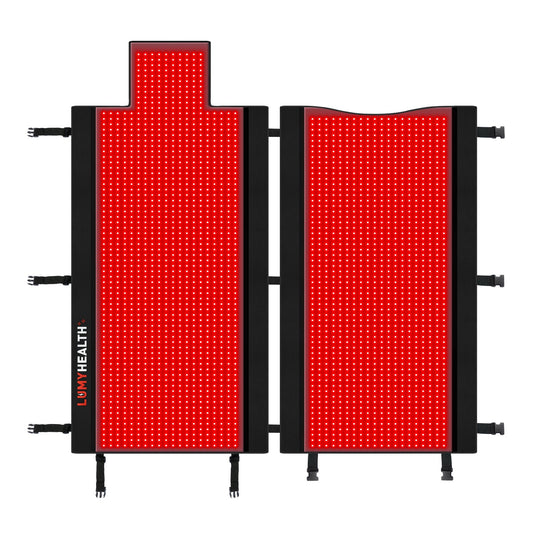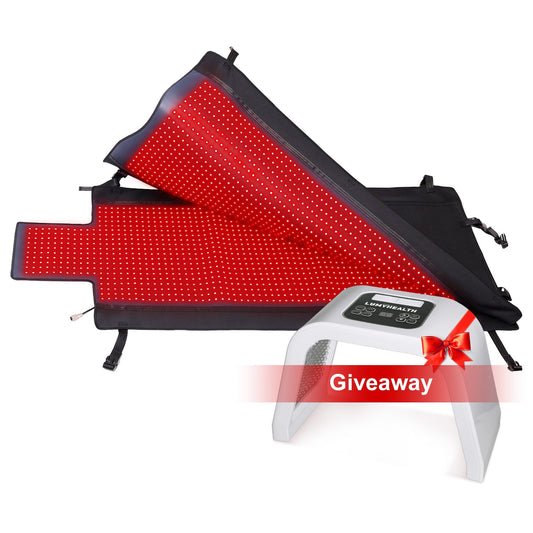Author: Dr. Chen, PhD
Dr. Chen has over 10 years of experience in photobiomodulation and neurorehabilitation research. She has published in journals and focuses on translating light-based therapies into practical clinical and home applications.
1. Introduction: Neuropathy and the Need for Non-Invasive Therapies
Neuropathy, characterized by chronic pain, numbness, and tingling, affects millions worldwide, especially in diabetic peripheral neuropathy (DPN) and chemotherapy-induced neuropathy. Traditional medications often provide partial relief and may cause side effects such as gastrointestinal distress or nerve toxicity.
Red Light Therapy (RLT), a non-invasive treatment using red and near-infrared light, has emerged as a promising approach for nerve repair, pain reduction, and functional recovery. Home-use devices, including the LumyHealth Red Light Therapy Bag, now make this therapy accessible outside clinics.

2. Mechanism: How Red Light Therapy Supports Nerve Health
RLT works through photobiomodulation (PBM), targeting cellular mitochondria to stimulate repair processes:
- Mitochondrial Activation: Light at 600–900 nm is absorbed by cytochrome c oxidase, increasing ATP production and cellular energy (Hamblin, 2017).
- Anti-Inflammatory Effects: RLT reduces pro-inflammatory cytokines such as TNF-α and IL‑1β in damaged nerves (Cheng et al., 2021).
- Nerve Regeneration: Near-infrared light enhances antioxidant enzyme activity, promotes axonal growth, and supports myelin repair (Ishiguro et al., 2010).
By addressing mitochondrial dysfunction, oxidative stress, and inflammation, RLT targets the root causes of neuropathic symptoms.
3. Evidence: Clinical Data on Red Light Therapy for Neuropathy
Key Human Studies
| Study | Condition | Therapy | Outcomes |
|---|---|---|---|
| Korada et al., 2023 | Diabetic peripheral neuropathy | PBM | Improved nerve conduction, reduced neuropathic pain (PubMed) |
| Argenta et al., 2017 | Chemotherapy-induced neuropathy | PBM vs sham | 32–53% pain reduction vs ~0% in sham (p<0.001) (PubMed) |
| Arnall et al., 2006 | Long-standing DPN | Pulsed infrared light (8 weeks) | Significant improvement in peripheral sensation (PubMed) |
Summary: Clinical data support RLT as a safe and effective method for improving nerve function, reducing pain, and enhancing quality of life.
4. Devices: LumyHealth Red Light Therapy Bag and Comparisons
LumyHealth Red Light Therapy Bag
- Coverage: Full-body, ideal for hands, feet, and extremities affected by neuropathy.
- Light Technology: Medical-grade red (660 nm) and near-infrared (850 nm) LEDs.
-
Clinical Guidance: Recommended 20–30 min sessions, 3–5 times per week.

Other Market Options for Comparison
| Device | LED/Diode Count | Wavelength | Notes |
|---|---|---|---|
| Vielight NIR Neuropathy | 290 LEDs | 810 nm | Focused on extremities, home-use approved |
| Tendlite Red Light | 60 LEDs | 660 nm | Handheld, spot therapy only, lower coverage |
| LumyHealth Bag | 2570 LEDs | 660 nm & 850 nm | Full-body, hands-free, dual wavelength for deeper penetration |
Takeaway: LumyHealth combines coverage, dual-wavelength therapy, and user convenience, while other devices may offer targeted but limited treatment.
5. Safety and Considerations
- Generally Safe: No known systemic side effects. Mild, temporary skin redness may occur.
- Contraindications: Avoid in photosensitive individuals or open wounds.
- Usage Tips: Keep device 2–6 inches from skin; do not overexpose; consult a healthcare provider if on medications affecting light sensitivity.
6. Future Directions: RLT and Neuropathy Innovations
Emerging trends:
- Wearable, continuous therapy: Smart fabrics with integrated LEDs for daily use.
- Combination therapies: RLT with stem cells or growth factors for enhanced nerve repair.
- Personalized dosing: Algorithms adjusting wavelength, pulse, and energy density for each patient (Rajeswari et al., 2024).
7. Conclusion: Is Red Light Therapy Right for You?
Red light therapy represents a scientifically validated, non-invasive approach to neuropathy management. With consistent use, can improve nerve function, reduce pain, and enhance quality of life.
While RLT is not a replacement for medical care, integrating it with conventional treatments offers a promising route for safer, effective neuropathy management.
References
- Korada HY et al. Effectiveness of Photobiomodulation Therapy on Diabetic Peripheral Neuropathy: A Systematic Review (2023) PubMed
- Argenta PA et al. PBM in Chemotherapy-Induced Peripheral Neuropathy (2017) PubMed
- Arnall DA et al. Pulsed Infrared Light Restores Sensation in Diabetic Neuropathy (2006) PubMed
- Ishiguro M et al. LED Irradiation Promotes Nerve Regeneration in Animal Model (2010) PubMed
- Cheng K et al. Mechanisms of Photobiomodulation in Neuropathic Pain (2021) PMC
- Hamblin MR. Mechanisms and Applications of Anti-Inflammatory Effects in PBM (2017) PMC
- Rajeswari SVKR et al. NIR Device Development for Diabetic Peripheral Neuropathy (2024) Nature





























